Revision Notes on Excretory Products and Their Elimination for NEET 2025 - Free PDF Download
Excretory Products and Their Elimination is a chapter from the Class 11 Biology syllabus. The chapter deals with the Excretory System of the human body, the organs, and the process of excretion. All the processes and diagrams are explained with proper definitions and examples in these revision notes for students to grasp the concept of the chapter in the easiest manner. In order to get a good understanding of the chapter, download and refer to Excretory Products and Their Elimination notes Class 11 for free. Created by the best subject matter experts at Vedantu, these notes would be helpful in your NEET preparation.
The most important topics and concepts related to the chapter are explained in the revision notes. Downloading these notes and including them in your study schedule will ensure that you are able to prepare for NEET in the best way. This is your chance to download Excretory Products and Their Elimination notes for NEET.
Note: 👉Get a Head Start on Your Medical Career with the NEET Rank and College Predictor 2024.
Access NEET Revision Notes Biology Excretory Products and their Elimination
Introduction
As a consequence of multiple metabolic reactions, the body produces a variety of harmful substances. Among other things, it includes urea, ammonia, uric acid, carbon dioxide, ions, and water.
Urea, ammonia, and uric acid are the three main types of nitrogenous wastes present in higher animals. Ammonia is among the most hazardous nitrogenous wastes.
Types of Organisms based on their Excretory Products:
1. Ammonotelic Animals:
They include most bony fishes but also aquatic amphibians, which eject ammonia as nitrogenous waste.
Diffusion is how ammonia is excreted.
2. Ureotelic Organisms:
They secrete urea as nitrogenous waste.
Examples include mammals, amphibians, and other ureotelic organisms.
3. Uricotelic Organisms:
Uricotelic animals such as reptiles and birds, detoxify uric acid as nitrogenous waste.
Types of Excretory Organs:
Different organisms have different excretory structures.
Amoeba and Paramecium possess contractile vacuoles for excretion.
The excretory system in sponges is identified as the canal system. Sponges expel waste via a canal system.
Hydra has the excretory cells called coelenteron.
Flame cells are found in Platyhelminthes.
Nephridia is found in Annelids such as earthworms.
Green excretory glands are found in prawns.
Malpighian tubules are the excretory system of insects.
Human Excretory System
Organs including two kidneys, two ureters, a urinary bladder, and a urethra comprise the human excretory system.
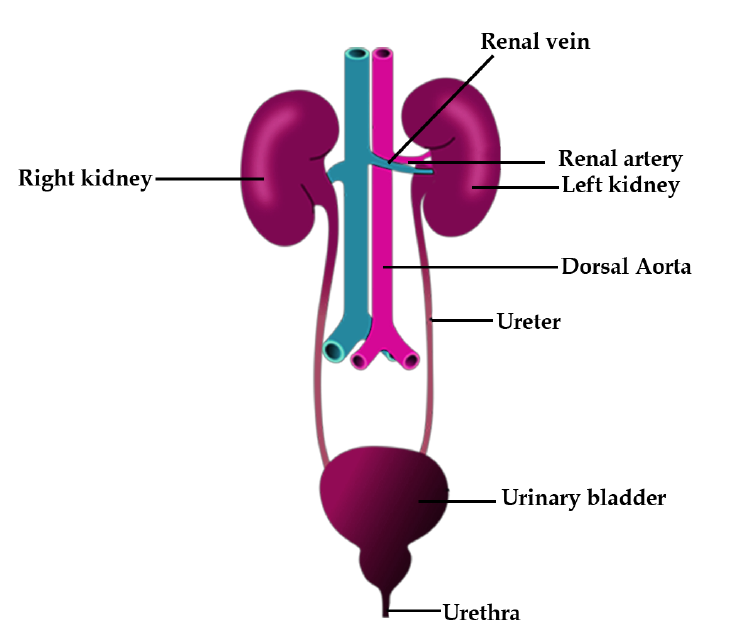
Human Excretory System
The kidneys are bean-shaped organs located in the abdomen. The right kidney is located a bit lower in the body as compared to the left.
The kidney's inner side is concave, while the outside is convex.
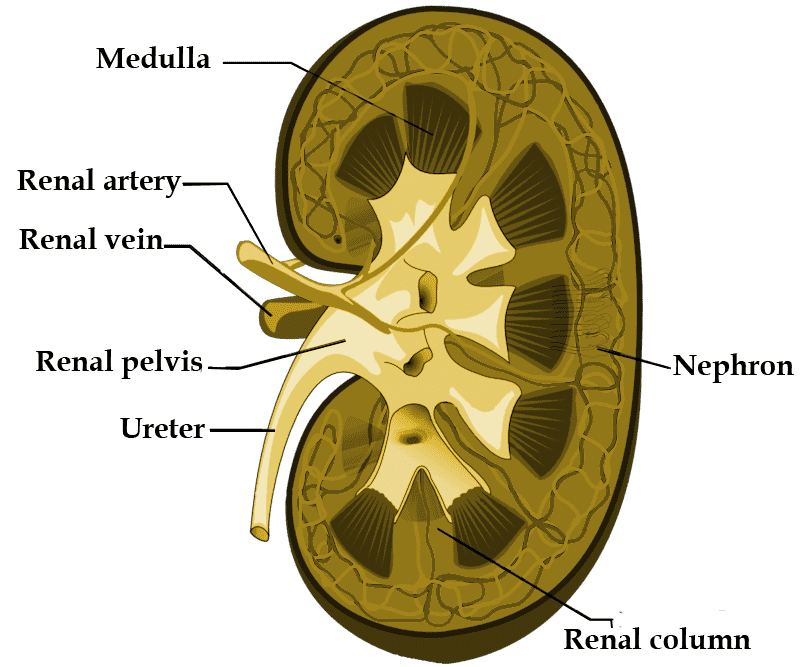
Kidney
The hilum is a notch located near the centre of the kidney's inner concave surface. It is the point where the ureter, blood vessels, as well as nerves, all enter.
A funnel-shaped site inside the hilum with calyces projections is referred to as the renal pelvis.
The kidneys are split into two parts: the outer kidney and the inner kidney.
The cortex is the outer portion of the kidney, and the medulla is the inner portion.
The medulla is partitioned into conical masses known as medullary pyramids.
Bertini's column is an extended form of the renal cortex that connects the pyramids.
Structure of Nephrons
The nephron is the kidney's basic function as well as a structural unit.
The renal corpuscle and renal tubule are two main components of the nephron.
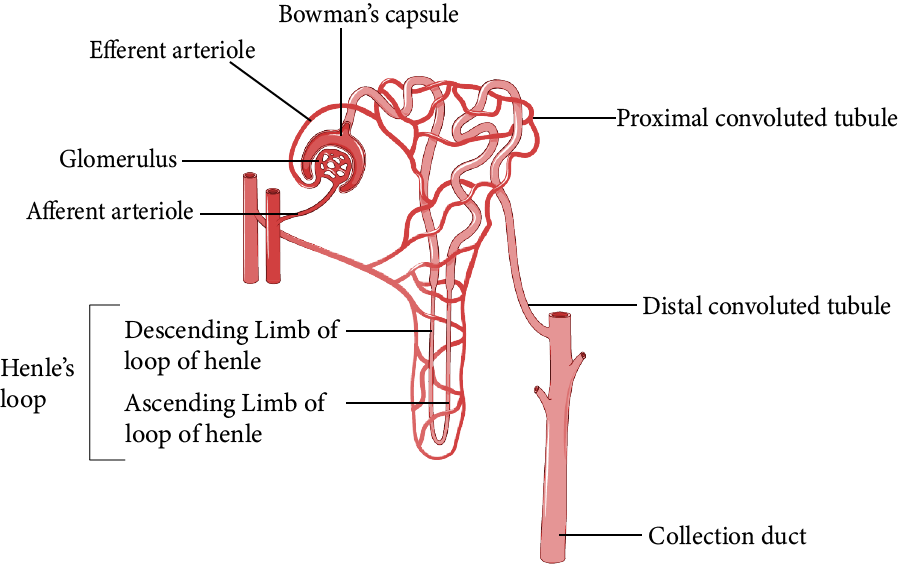
Nephron of Human Kidney
Renal Corpuscle/ Malpighian Body:
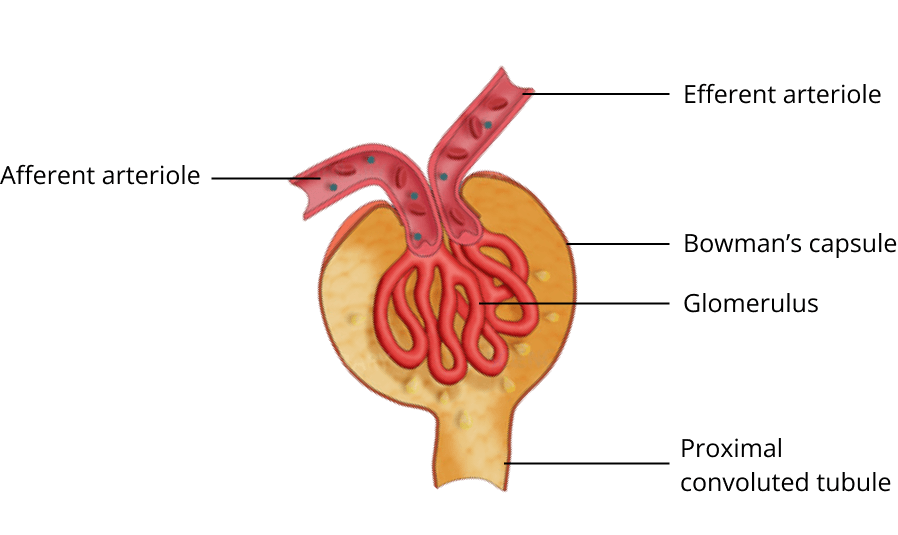
Renal Corpuscle
A glomerulus is formed by a tuft of capillaries.
The afferent arteriole carries blood into the glomerulus, whereas the efferent arteriole transports blood out.
The glomerulus is held together by Bowman's capsule, which is a cup-shaped structure.
Bowman's capsule, including the glomerulus, is termed the Malpighian body or renal corpuscles.
Renal Tubule:
The proximal convoluted tubule (PCT) is an elongated tube-like structure of the Malpighian body that is strongly coiled.
The tubule's next section is Henle's loop. Henle's loop has two limbs, one ascending and one descending.
A DCT i.e. distal convoluted tubule is formed by the ascending limb. After that, the DCT links to the collecting duct.
Types of Nephrons:
Cortical nephrons and medullary nephrons are the two major categories of nephrons.
Cortical Nephrons: Cortical nephrons are created when only a tiny fraction of the Henle loop is found in the medulla due to its short length.
Medullary Nephrons are created when the loop of Henle becomes too long and reaches the medulla.
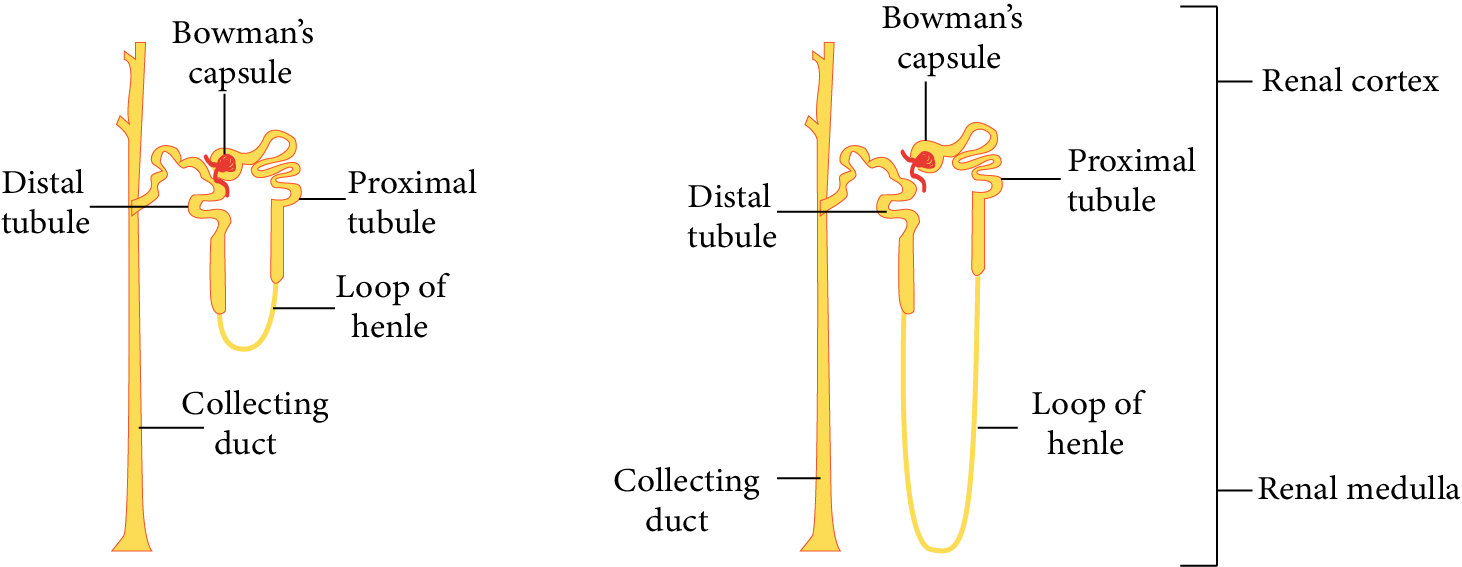
Types of Nephrons (Cortical and Juxtamedullary)
Urine Production
The process of urine formation completes in three steps which are:
Glomerular Filtration
Tubular reabsorption
Urine Secretion
1. Glomerular Filtration:
Glomerular filtration starts when blood travels the glomerulus by an afferent arteriole.
Water and nitrogenous waste pass through the glomerulus as well as blood cells, whereas proteins exit via the efferent arteriole.
On average, the kidney filters 1100 mL to 1200 mL of blood per minute.
Blood is filtered through three separate layers due to glomerular capillary blood pressure.
The endothelium, which encloses the glomerular blood vessels, is the first layer.
Bowman's capsule epithelium is the second layer, separated by a basement membrane.
Podocytes are Bowman's capsule epithelial cells that are positioned in an organised pattern to leave some tiny openings known as slit pores as well as filtration slits.
The glomerular filtration rate is the quantity of filtrate manufactured by the kidneys per minute.
2. Tubular Reabsorption:
Tubular reabsorption is the procedure of soaking up necessary molecules such as glucose, amino acids, and so on, or ions such as sodium ions, and so on.
Some substances are actively absorbed, while others are passively absorbed.
Water is passively (without energy) absorbed, whereas glucose and amino acids are actively (using energy) absorbed.
3. Urine Secretion:
Urine secretion is the last step in the production of urine.
To keep the ionic and acid balance of the body fluids, ammonia, potassium ions, hydrogen ions, etc, are released.
Functions of Nephron Tubules
1. PCT (Proximal Convoluted Tubules):
The proximal convoluted tubules are lined with simple cuboidal brush border epithelium.
This type of epithelium has a bigger surface area for reabsorption.
The majority of electrolytes, as well as water, are reabsorbed during PCT.
It helps to maintain the pH and ionic stability of body fluids by secreting ions like hydrogen, potassium, and ammonium into the filtrate.
2. Henle's Loop:
Henle's loop is very useful in maintaining the osmolarity of the fluid.
There is hardly any reabsorption in its ascending limb. It is impermeable to water but permeable to electrolytes.
The major part of the water is absorbed by the descending limb, which concentrates the filtrate. All electrolytes are nearly impermeable to the descending limb.
As a result, Henle's loop absorbs differently in different parts.
3. Distal Convoluted Tubule (DCT):
The distal convoluted tubule soaks up water, sodium ions, as well as bicarbonate ions while removing potassium ions and hydrogen ions to maintain fluid ionic balance.
4. Collecting Duct:
To concentrate the urine, the collecting duct reabsorbs lots of water.
Both Hydrogen ions and potassium ions are secreted by the collecting duct.
It maintains the ionic balance and pH of the blood.
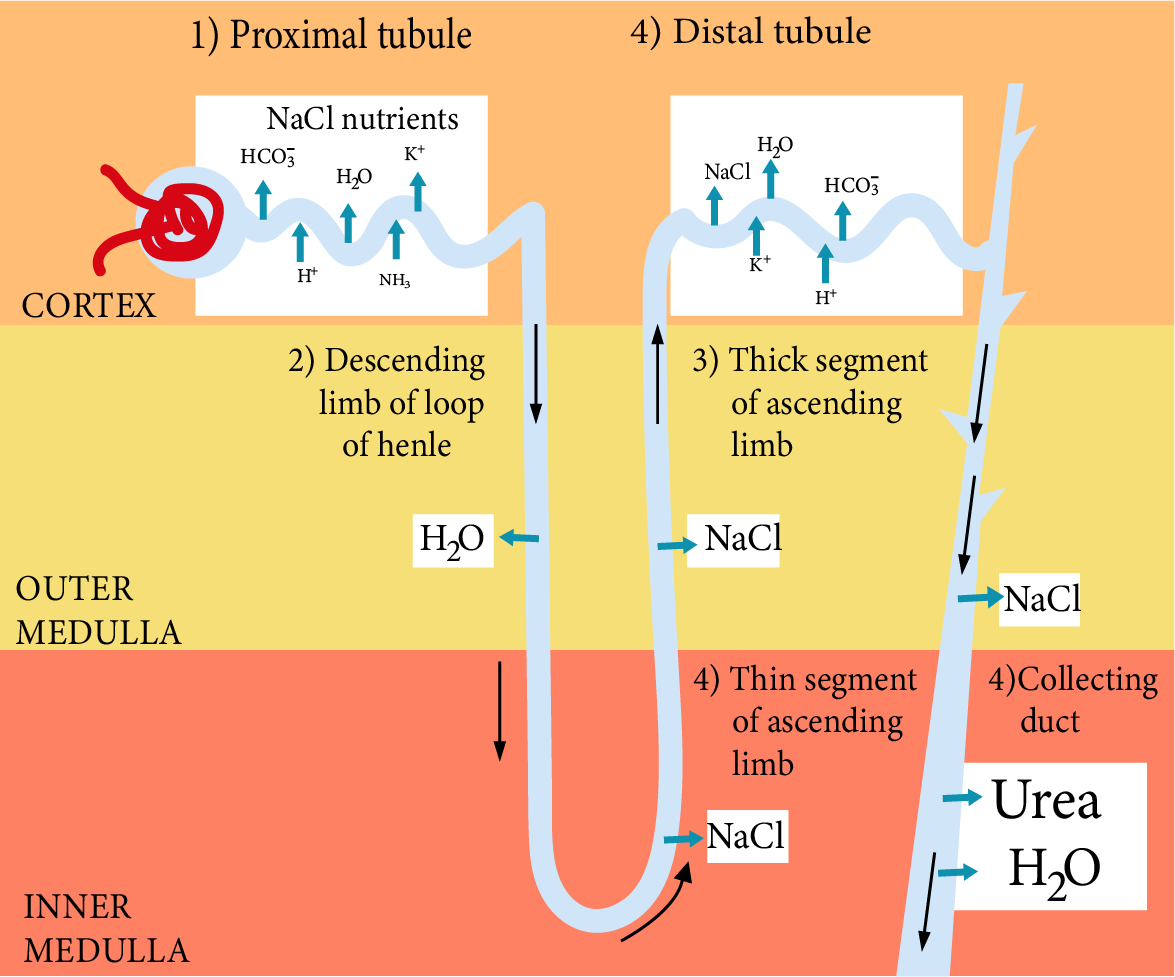
Functions of Different Parts of Nephron
Regulation of Kidney Functions
Kidney regulation is aided by hormones secreted by the hypothalamus, juxtaglomerular apparatus (JGA), and the heart.
Any change in blood density or ionic balance initiates the osmoreceptors in the body.
As a result, the hypothalamus secretes antidiuretic hormone (ADH)/ vasopressin.
This aids in the reabsorption of water from the tubules.
This causes an increase in blood volume and, as a result of a negative feedback loop, brings off the osmoreceptors.
The juxtaglomerular apparatus is initiated when glomerular blood pressure falls.
Juxtaglomerular cells secrete an enzyme called Renin, which transforms angiotensinogen in the blood to angiotensin I, which will then be converted to angiotensin II.
Angiotensin II tends to raise glomerular blood pressure as it is an effective vasoconstrictor.
Angiotensin II triggers the adrenal cortex to generate aldosterone, which raises the reabsorption of sodium ions and water by distal tubules.
The renin-angiotensin-aldosterone system (RAAS) is the name given to this procedure.
Renin - Angiotensin - Aldosterone - System (RAAS):
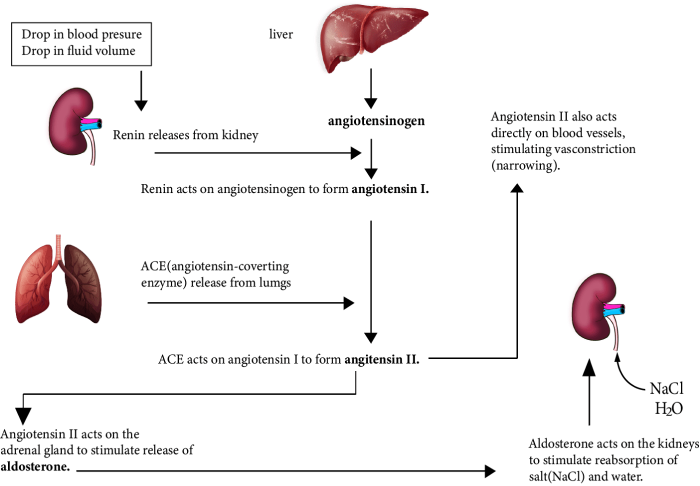
Renin-Angiotensin-Aldosterone- System (RAAS)
The Renin-Angiotensin-Aldosterone System (RAAS) controls kidney function.
The heart produces a polypeptide hormone known as an atrial natriuretic factor (ANF), which behaves as a vasodilator and hence lowers blood pressure.
It acts as a renin-angiotensin system negative feedback mechanism.
Micturition:
Micturition is the activity by which urine is excreted or released from the body. The CNS regulates it through a wide range of neural mechanisms.
Other Excretory Organs: Wastes including carbon dioxide, harmful chemicals, urea, and so on are eliminated by the lungs, liver, kidneys, and skin working together.
Dysfunctions of the Excretory System
Uremia is a buildup of urea in the blood caused by kidney failure.
Acute renal failure happens when one or both kidneys are damaged to filter urine and become unable to act for a range of reasons.
Renal calculi include kidney stones caused by the buildup of insoluble crystals including oxalates.
Glomerulonephritis is an inflammation of the globus pallidus.
Hemodialysis
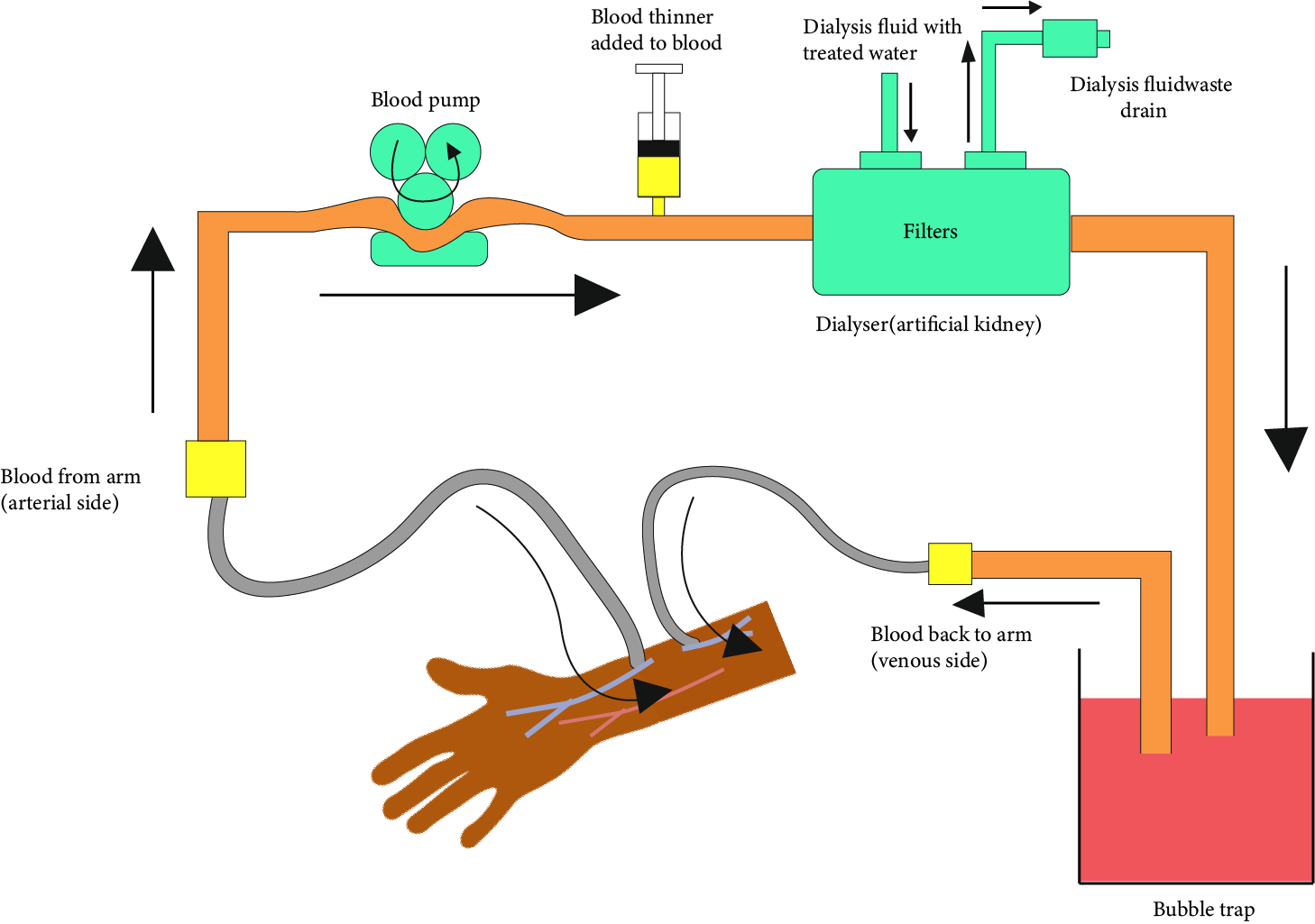
Procedure of Dialysis
Hemodialysis is a method of cleaning and purifying human blood.
It could be used to eliminate extra urea from the blood in cases of kidney failure.
To clean the blood, a dialysis device and a special filter known as an artificial kidney are used.
Blood is drawn from the body through cellophane tubules but also dialyzed against an isotonic fluid to extract wastes before being reintroduced.
It is prescribed for people whose kidneys are not functioning normally.
Hemodialysis necessitates a minor procedure, generally in the arm.
Points to Remember:
Many nitrogen-containing compounds, ions, carbon dioxide, water, and so on must be eliminated from the body.
The type of nitrogenous wastes created and their excretion differs between animals, owing primarily to habitat and availability of water. The main nitrogenous wastes excreted are ammonia, urea, and uric acid.
Animal excretory organs include protonephridia, malpighian tubules, nephridia, green glands, and the kidneys. They not only help to remove nitrogenous wastes, but also to maintain the ionic and acid-base equilibrium of body fluids.
The excretory system in humans consists of one kidney, two ureters, a urinary bladder, and a urethra. Each kidney contains millions of tubular structures known as nephrons.
The functional unit of the kidney is the nephron, which has two parts: the glomerulus and the renal tubule.
Glomerulus is a capillary tuft formed by afferent arterioles, which are fine branches of the renal artery.
The renal tubule begins with a double-walled Bowman's capsule and develops into a proximal convoluted tubule (PCT), Henle's loop (HL), and distal convoluted tubule (DCT).
Many nephrons' DCTs connect to a common collecting duct, many of which eventually enter into the renal pelvis via the medullary pyramids.
Bowman's capsule surrounds the glomerulus, forming the Malpighian or renal corpuscle.
Urine formation consists of three major processes: filtration, reabsorption, and secretion.
Filtration is a non-selective process that the glomerulus performs using glomerular capillary blood pressure.
The glomerulus filters approximately 1200 ml of blood per minute, producing 125 ml of filtrate in the Bowman's capsule per minute.
JGA, a specialised component of the nephrons, is important in the regulation of Glomerular Filtration Rate (GFR).
Almost all of the filtrate is reabsorption through various parts of the nephrons.
The primary site of reabsorption and preferential secretion is PCT.
The primary function of HL is to maintain the osmolar gradient (300 mOsmolL-1 -1200 mOsmolL-1) in the kidney interstitium.
The DCT and collecting duct allow for extensive water and electrolyte reabsorption, which aids in osmoregulation: H+, K+, and NH3 could be produced into the filtrate by the tubules to preserve the ionic balance as well as pH of body fluids.
A countercurrent mechanism exists between the two limbs of the Henle loop and those of the vasa recta, a capillary connected to the Henle loop. As it runs down the descending limb, the filtrate becomes more concentrated, but it is diluted along the ascending limb. This arrangement keeps electrolytes and urea in the interstitium.
The DCT and collecting duct concentrate the filtrate four times, from 300 mOsmolL-1 to 1200 mOsmolL-1 which is an outstanding water conservation mechanism.
Urine is deposited in the urinary bladder until a voluntary signal from the CNS causes it to be released through the urethra, a process known as micturition. The skin, lungs, and liver all help with excretion.
Importance of Excretory Products and Their Elimination for NEET
The chapter titled Excretory Products and Their Elimination is an important inclusion in the Biology Class 11 Syllabus. But it is also a very important part of the syllabus for students who are appearing for the NEET Entrance test. In the chapter, various organs and systems related to the process of excretion are discussed in detail for the students to understand. The excretory system of our body is an important mode of waste removal.
Different metabolic activities cause animals and human beings to accumulate different forms of uric acid, water, urea, ions, and carbon dioxide in the body. So, the process of elimination of these harmful components from the body is an extremely important one. In the chapter, students get to learn about the various sections of the excretory system in Human beings.
There are labelled diagrams and explanations provided for the Kidneys, Ureter, Blood Vessels, Nerves, and other important parts of the entire system in the Excretory Products and Their Elimination notes. Students will learn about the different types of nephrons (which are the parts of kidneys). The chapter also discusses the formation of urine in human beings and other animals. Other important concepts such as the Function of Tubules, Kidneys, and much more have been provided in the chapter for the easy understanding of students. They will learn about the regulation process in Kidney Function that includes different organs such as the Hypothalamus, RAAS, and others.
The roles of other important organs in the process of excretion as well as the various dysfunctions that take place in the excretory system have also been discussed in detail. These fundamental concepts will explain the entire human excretory system to the students which will further help them in preparing for their NEET entrance exam properly.
Benefits of Vedantu’s Notes for Excretory Products and Their Elimination
Students preparing for the NEET examination need a beneficial study resource that can provide them with the information that they need about the chapters. This is exactly what the Class 11 Biology Excretory Products and Their Elimination notes are for.
All the details about the chapter have been explained in an easy-to-understand language by subject matter experts at Vedantu. There are labelled diagrams to explain everything better.
NEET preparation will become a lot easier with these important notes. Just download the Excretory Products and Their Elimination Class 11 NCERT notes PDF and start studying.
Download Excretory Products and Their Elimination Notes Free PDF
Make your revision sessions more productive and efficient by downloading Excretory Products and Their Elimination NEET Notes PDF. Learn about the excretory system and practice the diagrams to understand the chapter better.
Other Important Links
Other Important Links for NEET Excretory Products and Their Elimination |
NEET Excretory Products and Their Elimination Important Chapter |
NEET Biology Revision Notes - Chapter Pages
NEET Biology Chapter-wise Revision Notes | |
Excretory Products and Their Elimination Notes | |
FAQs on Excretory Products and Their Elimination for NEET Notes 2025
1. What is the excretory product of different reptiles?
Reptiles are uricotelic animals that excrete some nitrogenous wastes in the form of uric acid. The excretion has minimum water discharge and forms a paste-like texture.
2. What are the components of sweat from the Sweat gland?
It is a fluid discharged from the sweat glands and contains NaCl with little quantities of Lactic Acid and Urea.
3. Name the excretory structure that the Amoeba uses?
The excretory structure of the Amoeba is called the Contractile Vacuole.
4. What gland is used by the Prawns for excretory functions?
The glands used by prawns for excretory functions are called antennary or green glands. These glands tend to secrete a portion of ammonia and have an opaque-whitish colour.


















